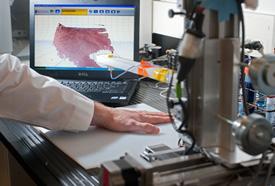Skin cell grafting
This scanner lets a bioprinter know exactly where to apply skin cells. It could save the lives of thousands of burn victims each year.
Wake Forest Institute for Regenerative Medicine in collaboration with the United States Army is designing a revolutionary technique for the treatment of burns victims. The technique involves a modified inkjet printer being mounted onto an assembly which could fit over a hospital bed. A laser then takes a reading of the wound’s attributes in order to calculate the most effective placement of skin cell grafts. Preliminary research has been carried out on mice, achieving positive results. The mice who received the treatment were reported to have healed wounds in two weeks, where a separate group of mice who did not receive the treatment achieved the same level of healing in five weeks. However, before human testing can begin, the next phase of testing needs to be conducted on pigs due to the similarities in skin tissue makeup.
One potential drawback of this technology is that it is likely to necessitate donor cells. It is currently unclear whether these would come from cultured skin cells or if multipotent stem cells could be deployed, increasing the number of fibroblasts and keratinocytes. While FDA approval will be required in order to carry out tests on humans, initial research suggests that wounds will be completely healed in a matter of weeks, as opposed to traditional skin graft techniques which are very painful and leave significant scarring. As well as the countless amounts of civilian burn injuries, it is estimated that are involved in around 10% of all war casualties. With such a large demographic that could benefit from this revolutionary procedure, hopefully it will be available on the market in the not too distant future!
Bone printing
In other areas of research, a procedure utilising inkjet technology has been invented for creating artificial bones, which can be inserted into the human body for healing purposes. This will be a massive leap forward from traditional methods which rely on either prosthetic substitutes or bone being transplanted from other areas of the body. A key advantage of this technique is that the printing process contains the same building blocks as actual human bone, allowing the implant to dissolve harmlessly away into the body after the repair process has taken place. It will be particularly useful when work needs to be done in areas that require a very specific shape to fit, such as cosmetic or reconstructive surgery. The designer bone also features a series of holes throughout in order for blood and cells to flow through, consequently strengthening its structure. With lengthy testing in progress, it will be some time before the public can reap the rewards of this new procedure. However, when it does finally arrive it may well prove to be revolutionary.
More useful applications of inkjet technologies in medicine include microneedles and organ transplantation.
Tim Phillips, Catenary Solutions
Further reading:

